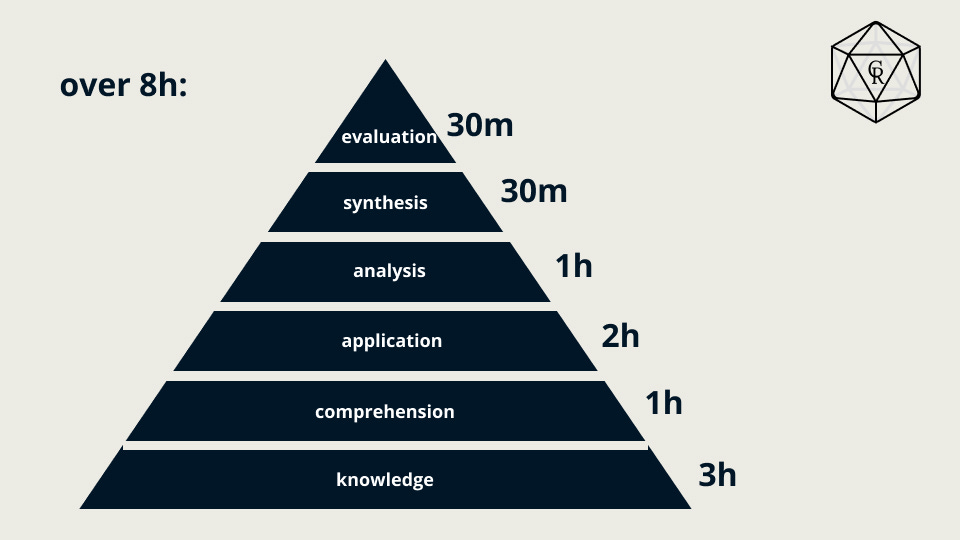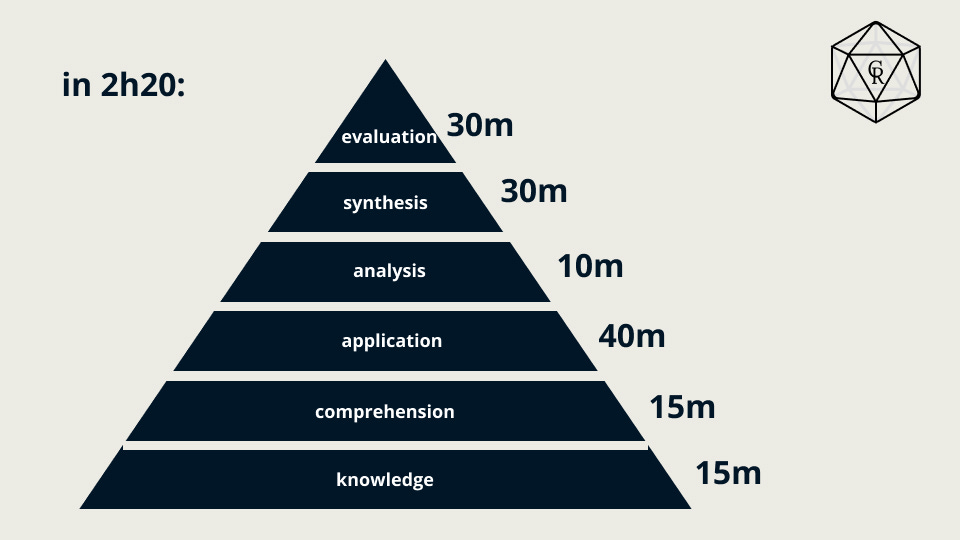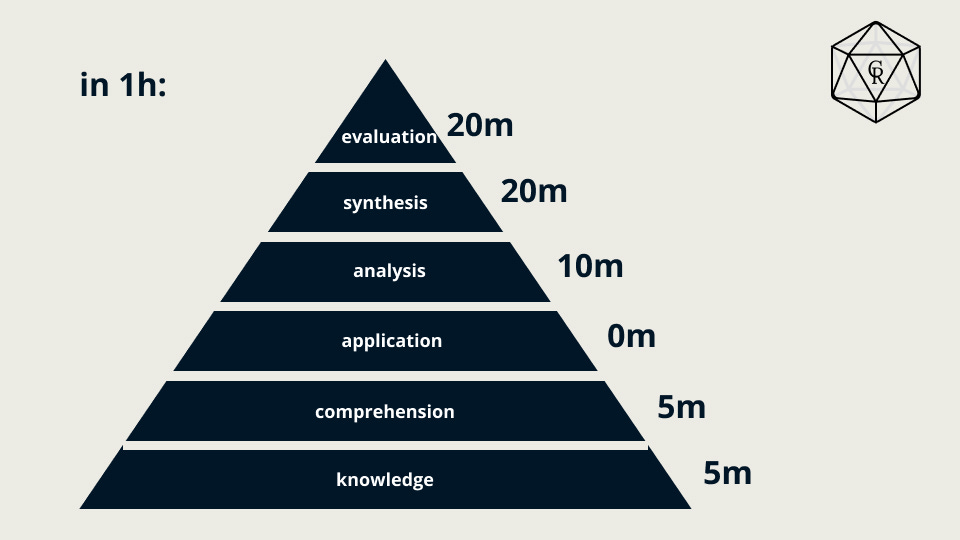Working with LLMs, Time & Focus
Observations on work done in collaboration with LLMs in the chat interface in summer 2025
cognitive resources and a 10x speed up
Yesterday I spent two hours and twenty minutes doing 8 hours of work. This miracle was performed in deep collaboration with ChatGPT and Manus AI, and I suspect that there are millions of folks performing these daily miracles across the planet.
The work I did wasn’t particularly special or important; I built a plan for an event, a slide deck to find speakers and sponsors, and an implementation schedule to keep the project on track. The banal nature of the example here I chose is deliberate; LLMs may in fact be amazing tools for cancer research or some other wildly difficult activity, however my own use-cases are much more run-of-the-mill.
In 2019, this type of activity would have taken me 8 hours, and would have involved only about 60 minutes of deeply difficult work that Bloom’s Taxononomy would have put in the upper tiers:

In 2025, there’s the new, improved time breakdown:
LLMs have dissolved almost every low-friction task. In the Old World, the tasks which were less demanding; link collecting, resizing screenshots, researching, tweaking language, are simply gone.
Everything left is essential work. Everything is a max-weight intellectual deadlift. The speed up is extraordinary; the cognitive resource demands are still 90% of what they would have been in 2019.
That physiological jolt is the phenomenological entry point for this essay: large language models do not merely save time—they change the energy profile of knowledge work. They strip away the gentle ramps and leave us on constant inclines.
old man yells at cloud
I am fully aware of the past versions of me who yelled about how typewriters destroy the cognitive flow of cursive writing, or how stories written in cursive no good compared to stories told around a campfire. This is true, but so is my experience yesterday.
the METR study
This week I had the pleasure of hearing Joel Becker and the METR folks talk through their study of developer productivity at a live event in SF. If you haven’t heard of this work, sixteen senior open‑source developers worked through 246 real issues in a big, complicated OS repo. When they were allowed to use AI tooling they moved 19 percent slower than when they coded unaided (metr.org). More striking, they believed they were 20 percent faster. The gap between perceived and real velocity suggests that LLMs mess up our internal metronome.
The Economist asked a sharper question last week—“Does AI make you stupid?”—noting that many workers feel tasks require less cognitive effort, even as output quality plateaus (economist.com)(archive v). Together these pieces frame a paradox: automation removes toil yet may sap momentum by front‑loading cognitive friction.
focus, not time, as the scarce resource
Classical productivity literature treats time as the limiting factor. In creative work the true bottleneck is uninterrupted, high‑quality attention—Cal Newport’s “deep work.” LLMs compress timelines by seconds but consume attention in larger, denser blocks. Each generated paragraph must be evaluated for factuality, tone, and coherence. That evaluative loop is ‘heavier’. Over a 90‑minute session the aggregate decision weight is hard on the grey matter!
Recent neuroergonomic research supports this view. An EEG study of AI chatbot interactions found reduced prefrontal engagement only when prompts were trivial; complex tasks pushed cognitive load back to baseline (frontiersin.org). The pattern matches my deck‑building fatigue: removing scaffolding tasks narrows the funnel until each remaining decision carries more subjective weight.
an idea for a study
I want to have groups of people come into a lab and have half use AI to complete tasks, half without. The task is about an hour without an LLM, and 15 minutes with an LLM. The tasks are difficult and cognitively demanding.
Participants can leave anytime they have completed the work. On the way out, they do a little “processing” where they answer questions about their experience, and then as they leave there’s two tables of snacks- one table loaded with healthy veggies and low-sugar options, the other full of chocolate cookies, cakes, and deeply unhealthy foods.
I bet you that the LLM-augmented participants will dive into the sweets at a dramatically higher rate, as they have used their willpower up aggressively. (shout-out Kathy Sierra). They have reduced capacity to make “good’ decisions.
physics of mental resources + willpower
Mental workload studies describe two competing forces: task complexity and time on task. LLM support lowers complexity for routine subtasks yet extends exposure to high‑complexity judgment calls. You exit a session with fewer completed minutes but higher cumulative strain. In aviation ergonomics the phenomenon is called the “automation paradox”: pilots fly fewer manual minutes while staying closer to the edges of the flight envelope when they do so.
Software engineering now inhabits a similar regime. The Buddha’s middle path is gone; work feels like alternating idling and red‑line RPM without a cruising gear. That mismatch triggers the subjective exhaustion I experienced and that Becker’s subjects likely masked with optimism bias.
Zoomers may not feel this way
Generation Z knowledge workers will never know the joys and horrors of shitty 2000s knowledge work. They will start from higher abstractions, just as touch‑typists never wrestled with typewriter ribbons. Their baselines will recalibrate around tool‑mediated flow. Yet there is reason to doubt that adaptation alone solves the fatigue issue. High‑performing esports athletes, who are natively digital, still exhibit measurable cognitive depletion after intense sessions of automated aim‑assist. The scarce variable is not familiarity but synaptic glucose.
this will not stay this way
Today is the worst these tools will ever be. This specific problem will go away- others will take its place. The shift by next year in a fully agentic world may be:
If this means 8x more “rotations” through a work day, we’re going to need to think carefully about how to design systems that don’t reduce your brain to mush after a single day of this type of effort.




